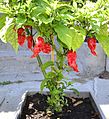This is an old revision of this page, as edited by Martinevans123 (talk | contribs) at 18:27, 9 May 2018 (Undid revision 840411267 by 2605:A000:160E:8078:7C92:B9CE:56FE:D615 (talk) as per source in article). The present address (URL) is a permanent link to this revision, which may differ significantly from the current revision.
Revision as of 18:27, 9 May 2018 by Martinevans123 (talk | contribs) (Undid revision 840411267 by 2605:A000:160E:8078:7C92:B9CE:56FE:D615 (talk) as per source in article)(diff) ← Previous revision | Latest revision (diff) | Newer revision → (diff)| Carolina Reaper | |
|---|---|
 | |
| Species | Capsicum chinense |
| Hybrid parentage | Bhut jolokia × red habanero |
| Breeder | Ed Currie |
| Origin | Rock Hill, South Carolina, US |
| Heat | |
| Scoville scale | 1,569,300 on average SHU |
The Carolina Reaper, originally named the HP22B, is a cultivar of the Capsicum chinense plant. The pepper is red and gnarled, with a small pointed tail. In 2013, Guinness World Records dubbed it the hottest chili in the world, surpassing the previous record holder, the Trinidad Scorpion "Butch T".
Pungency
The sensory heat or pungency detected when consuming a Carolina Reaper derives from the density of capsaicinoids, particularly capsaicin, which relates directly to intensity of chili pepper heat and Scoville scale. Bred in a Rock Hill, South Carolina greenhouse by "Smokin" Ed Currie, proprietor of the PuckerButt Pepper Company in Fort Mill, the Carolina Reaper was certified as the world's hottest chili pepper by the Guinness World Records since August 7, 2013. The official Guinness World Record heat level was 1,569,300 Scoville Heat Units (SHU) in 2013, according to tests conducted by Winthrop University in South Carolina. The figure is an average for the tested batch; the hottest individual pepper was measured at 2.2 million SHU.
The original crossbreed was between a Bhut jolokia (a former world record holder) and a red habanero, and is named 'Reaper' due to the shape of its tail.
For growing, the pepper has been described as "a good all-rounder to try at home" by UK ethnobotanist James Wong, who said that they require temperatures of at least 18–20 °C (64–68 °F) and suggested growing in 30–40 cm (12–16 in) pots to restrict growth and produce fruit sooner. It has been described as having a fruity taste, with the initial bite being sweet and then immediately turning to "molten lava". When fully ripe, two peppers occupy the palm of the hand.
In May 2017, Mike Smith of St Asaph working with Nottingham Trent University claimed to have surpassed the Carolina Reaper with his Dragon's Breath pepper, reported to be 2.4 million SHUs, and applied to Guinness World Records for confirmation. As of September 2017, the hottest chili pepper known was Pepper X, having a reported Scoville scale of 3.18 million units.
Gallery
References
- "About Us". PuckerButt Pepper Co.
Smokin' Ed gained the pepper industry's attention in November 2011 when an NPR Reporter stopped by to eat an HP22B pepper–now known as Smokin' Ed's Carolina Reaper®.
- "Confirmed: Smokin Ed's Carolina Reaper sets new record for hottest chilli". Guinness world records. 2013-11-19. Retrieved 2016-09-14.
- Nagy, Z; Daood, H; Ambrózy, Z; Helyes, L (2015). "Determination of Polyphenols, Capsaicinoids, and Vitamin C in New Hybrids of Chili Peppers". Journal of Analytical Methods in Chemistry. 2015: 102125. doi:10.1155/2015/102125. PMC 4606152. PMID 26495153.
{{cite journal}}: CS1 maint: unflagged free DOI (link) - ^ "Hottest chili". Guinness World Records. Retrieved July 11, 2014.
- ^ Hallock, Betty (December 26, 2013). "World's hottest pepper hits 2.2 million Scoville heat units". Los Angeles Times.
- Collins, Jeffrey (December 26, 2013). "World's hottest pepper is grown in South Carolina". Associated Press. Archived from the original on July 1, 2015.
{{cite news}}: Unknown parameter|deadurl=ignored (|url-status=suggested) (help) - ^ Tu, Chau. "Eating the 'Carolina Reaper' pepper is 'like eating molten lava'". pri.
- Duffy, Jim (Habanero). "Carolina Reaper". Super hot chiles.
Ed created this chile plant variety by crossing a Ghost pepper (Bhut Jolokia) with a Red Habanero type from St Vincents Island in the West Indies.
- Wong, James (February 28, 2016). "Gardens: the hottest chilli ever grown". The Guardian. Retrieved February 26, 2016.
- ^ Smithers, Rebecca (16 July 2016). "UK shoppers to feel the heat as world's strongest chilli hits the high street". The Guardian. Retrieved 25 March 2018.
- "'World's hottest' chilli pepper grown in St Asaph". BBC News. 17 May 2017. Retrieved 18 May 2017.
- Elizabeth Licata (23 September 2017). "Pepper X is the new hottest pepper in the world". The Daily Meal. Los Angeles Times. Retrieved 15 December 2017.


